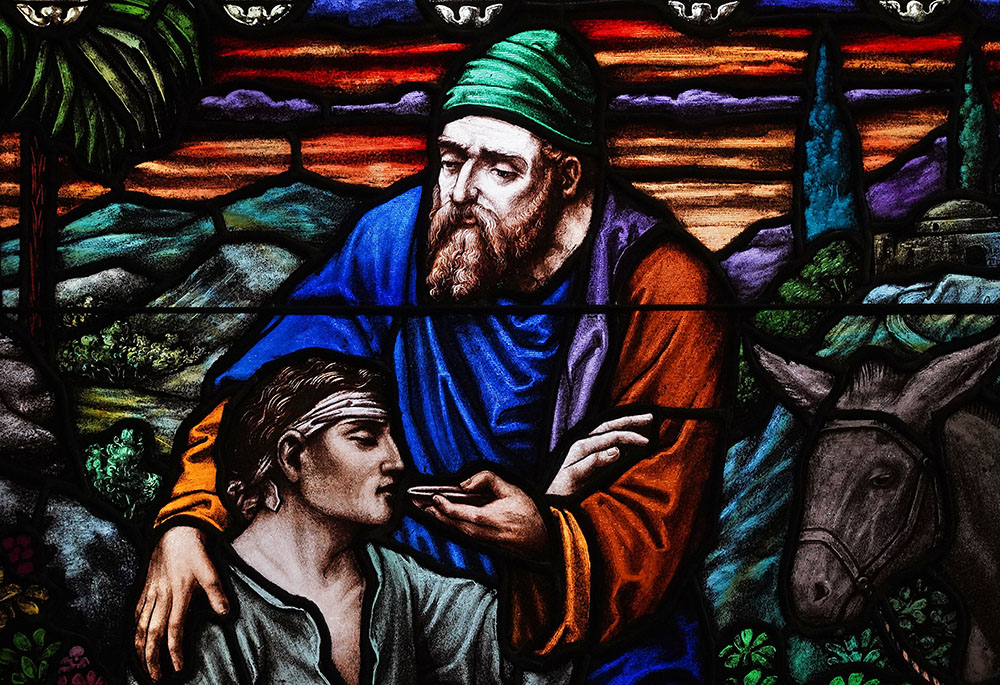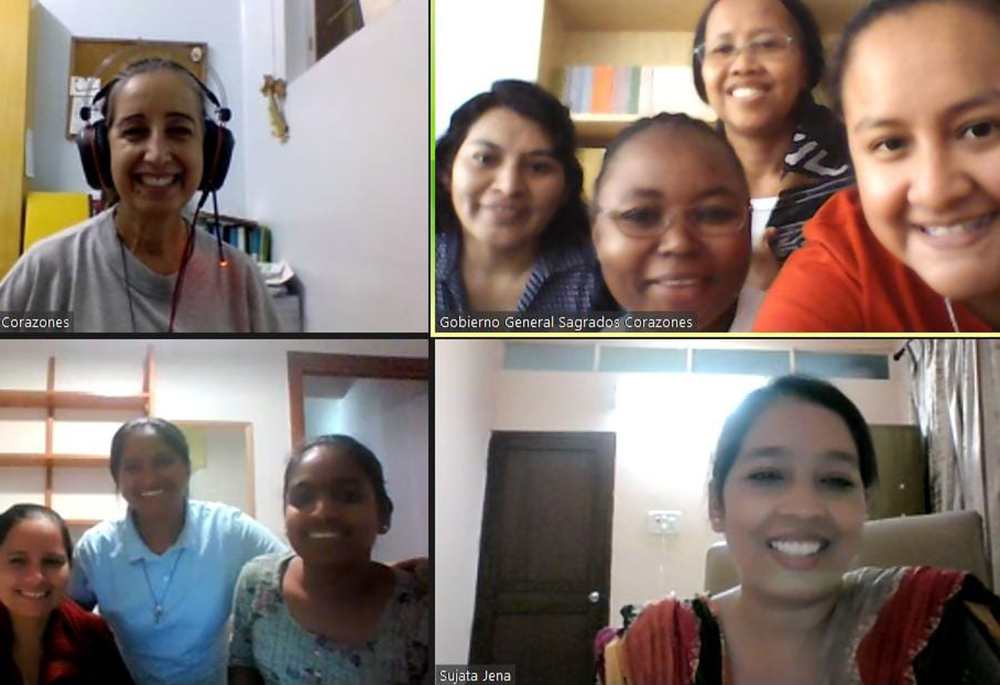
The parable of the good Samaritan is depicted in a stained-glass window at Good Samaritan Hospital Medical Center on World Day of the Sick, Feb. 11, 2021, in West Islip, New York. (CNS/Gregory A. Shemitz)
In September 2022, the Congregation of the Sacred Hearts of Jesus and Mary, the religious community to which I belong, invited me to address the international juniors on three topics: the kingdom of God, the mission of Jesus, and the apostolic zeal of the congregation.
The seven young sisters whom I was going to address were from Congo, Mexico, Peru and Spain, and three were from India, all preparing for final vows in Salamanca, Spain. We came together online for about two hours each day, for five days.
Before the session, I spent many days reflecting on the theme, especially on the content to be addressed, with some personal experience for each topic.
For my sharing, I took references from Scripture, post-Vatican church documents, a post-synodal apostolic exhortation, missiology subjects, documents related to the mission of the congregation, and also some personal lessons I had learned from my involvement in the mission from the time of my first vows.
For the last day's topic, "the apostolic zeal of the congregation," I decided to reflect with them on the parable of the good Samaritan as the road map for carrying out the mission of the congregation.
The story of the good Samaritan is one of the most well-known of Jesus' parables and a favorite story for many, including me. Also, during the COVID-19 pandemic, we have heard stories of many good Samaritans.
Recently, our congregation's council offered us a unique, creative, authentic and rich reflection on the parable of the good Samaritan. In a way, they proposed that we follow the road map of good Samaritans in carrying out the mission of the congregation.
So I had more reason to reread, reflect, and relive the passage of the good Samaritan with more passion and conviction, and I invited them to reflect with me.
Jesus told the story of the good Samaritan (Luke 10: 30-35) when a legal expert asked him what he must do to inherit eternal life. Jesus said, "Love your Lord God with all your heart, strength, and mind. Then love your neighbor." Then the man asked, "Who is my neighbor?"
Jesus told of the injured man ignored by the priest and Levite, but rescued by the Samaritan, who took three important steps: taking charge of reality, bearing reality, and taking care of reality.
Taking charge of reality means knowing how to look at reality. We have seen that "taking charge of reality" is not an easy task. Even though we know it is the right thing to respond with courage, creativity and compassion to people's suffering, we have an innate tendency to avoid the incident and take a detour past reality. Our blindness is because we are concerned about a few official rules and regulations of our religion and institutions, and fearful of being labelled unholy and unrighteous.
Advertisement
The first step in making the mission of the congregation different will be to see reality as it is. Honesty with what is real. Managing to grasp the truth and being able to respond to reality.
We ask ourselves: Why does only the Samaritan seem to see the man beaten and dead?
Why are there sisters in our congregation who take a detour in the presence of suffering to which we should be attending? What do we think we should take charge of?
Bearing reality means shouldering reality, creating "inns."
The Samaritan man takes pity on him, approaches, bandages him, puts him on his horse, takes him to the inn, and takes care of him.
Being honest with reality moves us to compassion or mercy. It's not just a feeling, but an action to alleviate suffering and take the risk of sharing the fate of the wounded one.
The Samaritan's road map involves "getting dirty." It requires taking sides, taking risks, and exposing yourself as being impure or unclean in the eyes of "official religion," of tradition, of what has always been done (the perspective of the priest or Levite).
Approaching reality through hospitality means dialoguing with a culture that welcomes and values other ways of understanding life, not absolutizing "my model."
It means listening to the grassroots; getting off our high horses and walking on the same level with others — listening to those who are never heard. The Samaritan suffers with the victim, breaks down the inequality, and draws himself closer until he is impure — from him we see what we must do.
What should I be responsible for? What moves me to compassion? Where do I begin?

Sujata Jena, bottom right, speaks to international juniors of the Congregation of the Sacred Hearts of Jesus and Mary in September; the sisters were preparing for final vows. (Courtesy of Sujata Jena)
Taking care of reality: The parable culminates in the complete care of the victim. The thieves had robbed him, leaving him half dead, and everyone has passed him by. Now the Samaritan takes care of him and gets someone else to take care of him; now the Samaritan pays and even promises to return.
This asks us to shift from structure to planning mode: From the urgency of "bandaging wounds" — that is, attending to the immediate — to a long-term path that generates adequate structures for the needs of the world, according to the reality of the congregation and in fidelity to the charism.
It is to live in a "network" society — being part of many small groups, in small places, doing small things, and bringing small transformations to the places we live or work.
We need to make our way of living understandable to people and create countercultural communities that live soberly, are welcoming, and are willing to share with the neediest.
We are invited to reflect on whether another spirituality is possible. What is possible? Other relationships are possible. What are the other relationships? Another commitment is possible.
What is it? With whom will I make it possible?
At the end of the session, we had an open forum for discussion. Invariably, all the sisters expressed that the parable of the good Samaritan is indeed a perfect example of taking part in building God's kingdom of love, justice and peace with compassion, competence and care.
The sisters shared their stories of witnessing many good Samaritans around them, starting with their families, communities and society.
When we talked about getting "dirty" or taking risks, a young sister from Congo said that she liked the story of the good Samaritan, but that sometimes it is difficult to follow its example. She told of how two wandering children were taken in by her community late one night. Their stories were a bit complicated and the sisters needed the intervention of the local authorities. It was quite risky for the sisters' community to keep the children with them and take care of them.
However, the Samaritan road map teaches us to respect moments, and balance between "the traditional" and "the new." It invites us to a new way of looking at reality and responding to reality in a way that is true to our identity as children of the same Father, as Christians, and as religious people.
We need to strengthen our "inns" and invent more "inns" to live in a mutual relationship and solidarity. Yet it is not just a feeling but taking action to alleviate suffering, and taking the risk of sharing the fate of the wounded.
May the parable of the good Samaritan open our minds and hearts to see reality, bear reality, and take care of reality.





